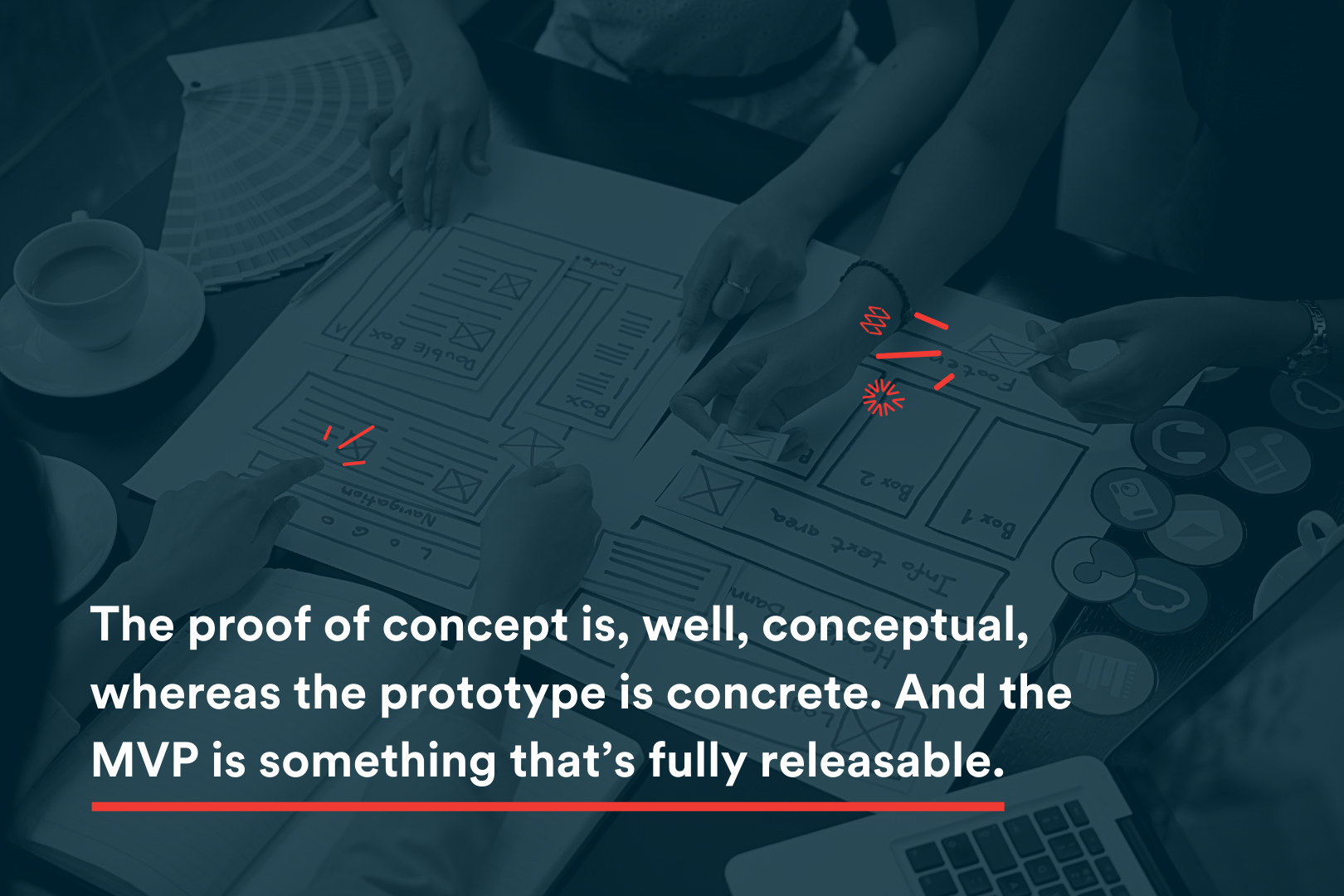software development | proof of concept
In the lifespan of a tech venture, there is both a beginning and an end.
The beginning is an idea. It’s ethereal, conceptual, something that exists only in our minds, doodled on the back of a napkin, or sketched out on a whiteboard.
On the other end of the tech spectrum, after all the hard work and development, is the end product. It’s the idea shaped into reality, tried and tested and put through the wringer in order to come up with viable hardware or software that addresses a need in the marketplace going unfulfilled.
But there’s one key stop on the journey that every tech idea should go through, long before you go into production, before Q & A testing, even before development and prototyping:
Proof of concept.
In this article, we’ll define proof of concept, detail how to go about the creation of a proof of concept and the many forms it can take, weigh the differences and similarities to prototyping and a minimum viable product, and further emphasize why this is your best shot at winning the hearts and minds of your internal stakeholders and, eventually, your end product’s end users.
Proof of Concept Defined
At its heart, the definition of proof of concept is relatively straightforward. It’s a clearly defined sketch (either written or illustrated) of the tech that will be used within an end product.
To flesh that out a little more, a viable proof of concept should do three things in order to demonstrate that your idea can go the distance. You should be able to show:
1. The business case for a product (the why)
You technically don’t need a reason to create a product. Maybe you just got a flight of fancy and want to create something unique that can maybe, someday, in the future be turned into something innovative. But that kind of freewheeling development doesn’t fly in the tech and business world; if you want your product to be turned into something actionable, you need a business problem to tackle. You have to show investors and key stakeholders why there’s a need in the first place.
2. The solution the product provides (the how)
With the business case established, you can then briefly demonstrate how the final product is going to solve the business problem.
3. The inner workings of the product (the what)
These are the properties that make your proof of concept unique and actually enable the solution to the business problem. It’s here where you explore the software, hardware, data, and various mechanisms necessary to create something your target audience will actually use.
Where to Start and What It Looks Like
The first two points (the why and the how) won’t take up very much space. They might consist of a line or two to describe the problem and the solution. Or, if you’re presenting to the C-suite in a PowerPoint, these might be explored within a couple of slides that allow you to vocalize the business case more thoroughly.
The bulk of your proof of concept will be composed of “the what,” the actual technological processes that make the end product possible. It’s here where you describe the tools in use within the end product, how those tools will interact in a unique way, and how this coordination will result in something that otherwise would not exist.
Depending on the type of product you’re putting together, your proof of concept might take one of a few different forms.
- Sketch
If you’re developing a new physical product, the easiest way to communicate the concept might be to actually sketch out what it will look like. This is typically accompanied by a cross section drawing or interior image that highlights the inner workings of a product even if those inner workings are something the end user will never see. Think of patent sketches, and you have the right idea.
- Written Descriptions
If you’re dealing in software or coding, the easiest way to produce a concept may be to explain, narratively, how the application will work, including the coding languages and processes in use and how they interact with each other.
- Wireframe
As systems and workflows become increasingly complex, so do the products tech companies create, often involving dozens of integrations and processes flowing from one aspect of tech development to another. In scenarios where your product is the result of intertwining processes and data sources, a wireframe that takes the reader/viewer through the totality of the product can be your best bet.
- Presentation
If your product is complex or just needs executive buy-in, a presentation format combining all of the above along with supplemental materials meant to entice your company leaders is likely the best format for your proof of concept.
Okay, But How is This Different from a Prototype or Minimum Viable Product?
A proof of concept is what it sounds like, proof that the concept could be turned into a viable product. A prototype is an early, warts-and-all version of that product.
Some companies and inventors might go right to the prototype stage to demonstrate that the concept works, particularly if the product is relatively simple or straightforward or if having the hardware or software available to physically touch or interact with helps the user understand what it is.

This is different from a Minimum Viable Product (MVP), which is even further along than the prototype. An MVP is a simple application or physical item, centered around a few critical features, that enables you and your business to begin gathering feedback early and often. Although it’s far from what would be an ideal design or end product, it’s something that could be released as a beta, a demo that showcases the ideas behind the product, or even a product in and of itself (so long as it’s communicated to the user that further updates and enhancements will be made).
In most cases, these are all completely separate steps on the journey. The proof of concept is, well, conceptual, whereas the prototype is concrete. And the MVP is something that’s fully releasable, albeit with the understanding further improvements are incoming.
Why Proof of Concept is a Step You Should Never Skip
When it comes to most software and even hardware, especially new products with interwoven technologies and code, proof of concept is an absolute must. The roadway to having even a prototype can be long, and getting your ideas down in the proof of concept is essential to showing that what you’re working on is even possible. It helps you make the most of your time and ensures your resources are optimized to their fullest extent.
Once your proof of concept is solidified, it’s then you can begin establishing timelines, project leads, and the actual nuts and bolts of the work your team will put in to make the idea a reality, testing and refining as you go.
If you’ve got an idea for something that solves a business problem and need help getting your ideas into a proof of concept that acts as a vehicle for further development, let’s talk. Aviture has experience developing proofs of concept across multiple industries and various technological foundations, and we’d be thrilled to learn more about your needs so we can help you innovate in your space.





